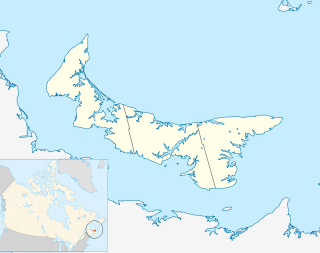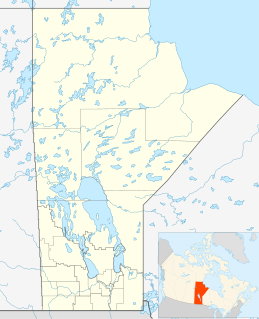
The British Commonwealth Air Training Plan (BCATP), or Empire Air Training Scheme (EATS) often referred to as simply "The Plan", was a massive, joint military aircrew training program created by the United Kingdom, Canada, Australia and New Zealand, during the Second World War. BCATP remains as one of the single largest aviation training programs in history and was responsible for training nearly half the pilots, navigators, bomb aimers, air gunners, wireless operators and flight engineers who served with the Royal Air Force (RAF), Royal Navy Fleet Air Arm (FAA), Royal Australian Air Force (RAAF), Royal Canadian Air Force (RCAF) and Royal New Zealand Air Force (RNZAF) during the war.

Canadian Forces Base Summerside was an air force base located in St. Eleanors, Prince Edward Island, Canada, now part of the city of Summerside.

Canadian Forces Base Greenwood, or CFB Greenwood, is a Canadian Forces Base located 1.5 nautical miles east of Greenwood, Nova Scotia. It is primarily operated as an air force base by the Royal Canadian Air Force and is one of two bases in the country using the CP-140 Aurora and CP-140A Arcturus anti-submarine/maritime patrol and surveillance aircraft. Its primary RCAF lodger unit is 14 Wing, commonly referred to as 14 Wing Greenwood.

RCAF Station Kingston was a World War II air training station built in 1940 at Collins Bay near Kingston, Ontario, Canada. The station was originally built by the Royal Canadian Air Force (RCAF) for use by the Royal Air Force (RAF). Like other RAF schools in Canada, it was subject to RCAF administrative and operational control.

RAF Station De Winton was a World War II air training station located south of Calgary, and east of De Winton, Alberta, Canada. The Royal Air Force (RAF) established No. 31 Elementary Flying Training School at the station. Like other RAF stations in Canada, it was subject to RCAF administrative and operational control.
RCAF Station Fort Macleod was a World War II British Commonwealth Air Training Plan (BCATP) flying training station. Administrative and operational control was the responsibility of the Royal Canadian Air Force (RCAF). The old station is located south of Fort Macleod, Alberta, Canada.

RCAF Station Mount Pleasant was a Royal Canadian Air Force (RCAF) station in Mount Pleasant, Prince Edward Island, Canada. Two of its runways remain in use by members of the Experimental Aircraft Association.

RCAF Station Pennfield Ridge was a Royal Canadian Air Force training station located in coastal Charlotte County, New Brunswick in the hamlet of Pennfield Ridge.

Several air force stations and other establishments, many of them training facilities, operated in Calgary, Alberta, Canada from the mid-1930s to the mid-1960s.

RCAF Detachment Gananoque was a relief landing field for the Royal Air Force's No. 31 Service Flying Training School (SFTS) located at RCAF Station Kingston during the Second World War. The airfield was located north of Gananoque, Ontario, Canada. Gananoque consisted of a triangle-shaped runway pattern, one hangar, and a control tower. Gananoque officially became a British Commonwealth Air Training Plan (BCATP) facility in 1942 when RAF training schools became part of the BCATP. The station opened in 1940 and closed in 1945.

RCAF Station Assiniboia was a Second World War British Commonwealth Air Training Plan (BCATP) flying training station located near Assiniboia, Saskatchewan, Canada. It was operated and administered by the Royal Canadian Air Force (RCAF).

CFB Rivers was a Royal Canadian Air Force base located 5 km (3.1 mi) southwest of Rivers, Manitoba, Canada at the junction of Manitoba Highway 25 and Manitoba Provincial Road 259.

Royal Canadian Air Force Station Jarvis was a Second World War British Commonwealth Air Training Plan (BCATP) station located near Jarvis, Ontario. The station was home to No. 1 Bombing and Gunnery School and is usually known by that name. Bombing and Gunnery schools trained Air Gunners, Wireless Air Gunners, Air Observers, Air Bombers, and Navigator-Bomb Aimers. These airmen served as aircrew on bombers and maritime patrol aircraft.
No. 1 General Reconnaissance School RCAF was a flight training unit in 3 Training Command, of the Royal Canadian Air Force, flying Avro Ansons from RCAF Station Summerside, PEI.
No. 2 Air Navigation School was a navigation training school in No. 3 Training Command RCAF, of the British Commonwealth Air Training Plan("BCATP"), flying Avro Anson's from RCAF Station Pennfield Ridge. It was opened on 21 July 1941 and closed on 30 April 1942. A second school with the same number opened at RCAF Station Charlottetown on 21 February 1944 and closed on 7 July 1945.
No. 9 Service Flying Training School (SFTS), Royal Canadian Air Force, was a flight training school, located at RCAF Station Summerside, PEI, and later, RCAF Station Centralia, Ontario. It was part of No. 3 Training Command RCAF, carrying out British Commonwealth Air Training Plan (BCATP) training operations.
No. 13 Service Flying Training School RCAF was a RAF flight training unit flying Avro Ansons from RCAF Station St Hubert, Quebec and later from RCAF Station North Battleford, Saskatchewan. It was part of No. 3 Training Command RCAF carrying out British Commonwealth Air Training Plan ("BCATP") operations.

Royal Canadian Air Force Station Dunnville was a Second World War British Commonwealth Air Training Plan (BCATP) station located near Dunnville, Ontario. The station was home to No. 6 Service Flying Training School and is usually known by that name. Service Flying Training schools trained pilots, either single engine or multi-engine, and 6 SFTS was a single engine school. After graduation the new pilots were assigned various duties, which might be overseas in the Royal Air Force or an RCAF squadron; or in Canada as instructors or staff pilots in the BCATP, or for duty in RCAF Home Defence squadrons.

RCAF Station Estevan was a World War II, British Commonwealth Air Training Plan (BCATP) base operated by the Royal Canadian Air Force (RCAF). It was located South of the City of Estevan, Saskatchewan, Canada.












